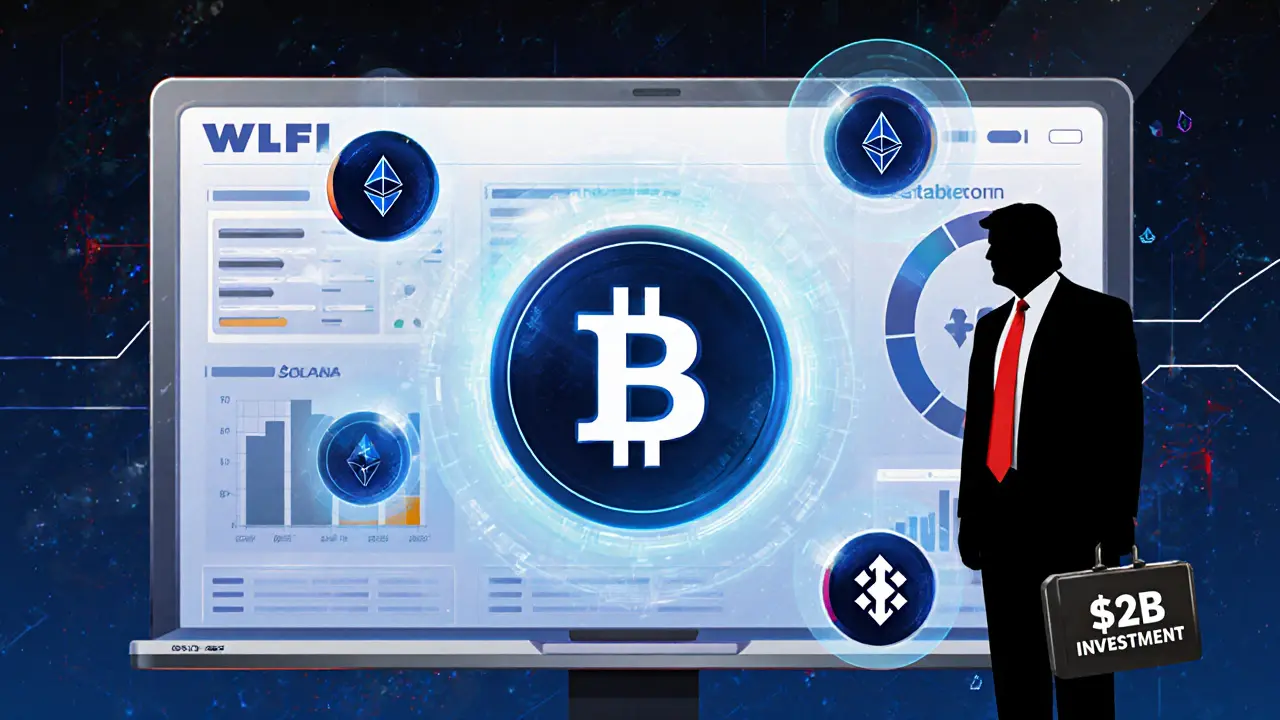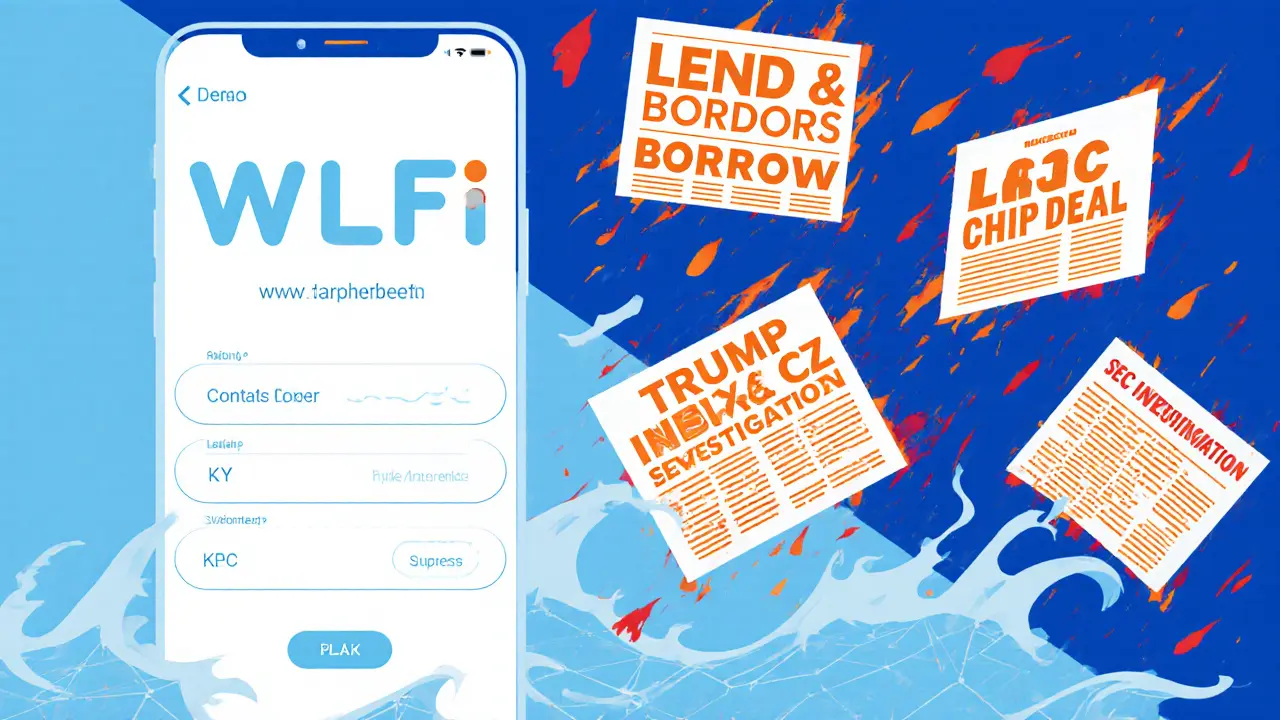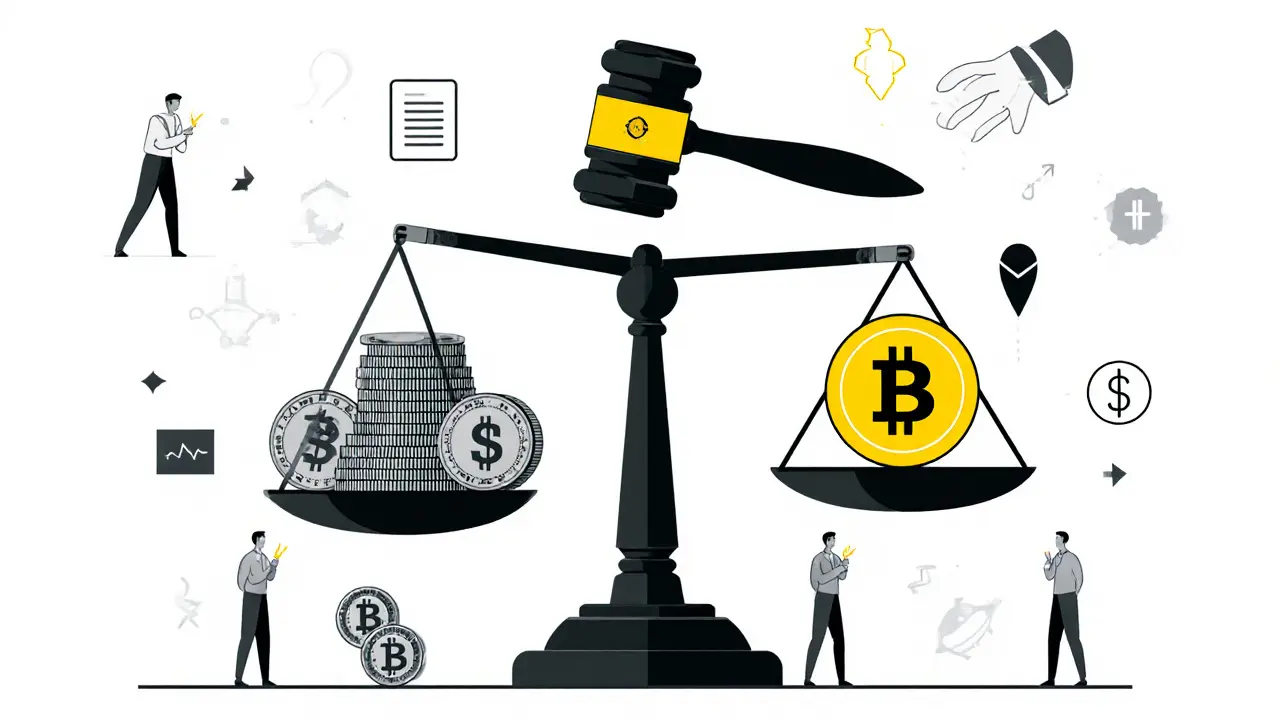Nov 1, 2025, Posted by: Ronan Caverly

WLFI Investment ROI Calculator
Calculate Your WLFI Investment Returns
See potential profit or loss based on historical price data from the article. Note: Prices are subject to market volatility.
Investment Results
World Liberty Financial, or WLFI, isn’t just another cryptocurrency. It’s a financial protocol wrapped in political controversy, backed by institutional cash, and built on a model no other crypto project has dared to copy. Launched in 2024, it claims to bridge traditional banking with decentralized finance - but its rise has been anything but normal.
What Exactly Is WLFI?
WLFI is the governance token for World Liberty Financial, a DeFi platform that offers a suite of financial tools centered around its USD1 stablecoin. Unlike most crypto projects that stay quiet on politics, WLFI openly ties itself to former U.S. President Donald Trump. According to reports, Trump personally earned hundreds of millions from the project, and his administration allegedly approved major deals with investors in the company - including a $2 billion token purchase by a firm linked to the Abu Dhabi government.
The WLFI token is an ERC-20 token originally issued on Ethereum, but it now runs on Binance SmartChain and Solana too. Total supply is capped at 100 billion tokens. As of October 30, 2025, about 24.57 billion are in circulation, trading at $0.1378. That gives it a market cap of $3.38 billion - enough to rank it #32 among all cryptocurrencies.
How WLFI Works: USD1, Lend & Borrow, and the App
WLFI isn’t just a token. It’s a full financial ecosystem:
- USD1 - A stablecoin pegged 1:1 to the U.S. dollar, backed by cash and U.S. Treasury bonds. Users can deposit crypto or bank funds to mint USD1, then use it for lending, borrowing, or payments.
- Lend & Borrow - Users can supply digital assets to earn interest or borrow against their holdings. The platform tracks a real-time health factor to prevent liquidation.
- WLFI App - The main interface for users. It connects to bank accounts, supports crypto deposits, and lets you manage USD1 and WLFI tokens. KYC verification takes 24-72 hours, and minimum deposits are $100 via bank transfer or $10 via crypto.
The platform is designed to make DeFi feel like a traditional bank app - simple, fast, and familiar. But behind the clean interface lies a web of controversy.
The Token Wasn’t Always Tradable - Here’s How It Changed
When WLFI first launched, you couldn’t sell or trade your tokens. They were locked. That changed in July 2025, when the community voted overwhelmingly to make WLFI tradable. The vote passed on July 17, 2025, and trading opened shortly after.
This wasn’t just a technical update - it was a major shift in the project’s identity. Originally, WLFI wasn’t structured as a DAO. Holders had no voting rights beyond this one-time decision. Now, the token has liquidity, and traders are active. On-chain data shows over 125,200 unique holders as of late October 2025.
Price History: From $0.46 to $0.09 - and Back Up
WLFI’s price has been wild:
- All-time high: $0.46 on September 1, 2025
- All-time low: $0.09152 on October 10, 2025
- Current price (Oct 30, 2025): $0.1378
That’s a 70% drop from its peak. But after hitting its low, it bounced back 50% in just 21 days. This kind of volatility is common in crypto, but WLFI’s swings are tied to news - not just market trends.
When Trump pardoned Binance’s CEO Changpeng Zhao, WLFI surged. When Bloomberg reported the SEC was investigating potential Foreign Corrupt Practices Act violations, it plunged. The price doesn’t react to technical indicators - it reacts to headlines.

Who Owns WLFI? The Distribution Breakdown
Unlike most crypto projects that give large chunks to founders or VCs, WLFI’s token distribution is unusual:
- 35% - Public sale
- 32.5% - Community growth and incentives
- 30% - Initial supporters (mostly institutions)
- 2.5% - Team and advisors
This structure suggests the project was designed to attract big money early - and it did. The Abu Dhabi-linked firm bought $2 billion in tokens. Chinese billionaire Justin Sun invested $30 million right after Trump took office in 2025. Coincidentally, that’s when the SEC dropped its investigation into Sun.
These aren’t random investments. They’re strategic moves tied to political shifts - and that’s what makes WLFI dangerous to regulators and fascinating to investors.
Controversies: Politics, Power, and Perceived Corruption
WLFI’s biggest selling point is also its biggest liability: its ties to power.
The New York Times called it “eviscerating the boundary between private enterprise and government policy in a manner without precedent in modern American history.” Why? Because:
- A $2 billion WLFI purchase by a UAE-linked firm was followed by the Trump administration approving a deal to sell them hundreds of thousands of scarce, advanced computer chips - despite national security warnings.
- Trump pardoned Changpeng Zhao, whose company Binance helped enrich World Liberty Financial.
- Justin Sun’s $30 million investment came right after an SEC probe against him was quietly dropped.
The SEC opened a formal investigation into possible Foreign Corrupt Practices Act violations in September 2025. JPMorgan analysts warn WLFI’s political entanglements create “unsustainable regulatory risk.” But ARK Invest still believes WLFI could capture 5-7% of the stablecoin market by 2027.
Is WLFI Safe to Use?
Technically, yes - if you’re okay with the risks.
The USD1 stablecoin has maintained its 1:1 peg since launch. The Lend & Borrow system works reliably. The app is intuitive for crypto-savvy users. But here’s what users complain about:
- Bank verification takes 2-3 days
- Cross-chain bridges (Ethereum to Solana) can delay transfers by 3-5 hours during peak times
- Customer support takes 18 hours on average to respond
- Some users report unexpected account freezes during KYC
Trustpilot gives it a 3.8/5. Reddit users praise the interface but curse the delays. Twitter sentiment is split: 58% positive about tradability, 20% negative about politics.

How Does WLFI Compare to Other DeFi Projects?
Here’s how WLFI stacks up against major DeFi platforms:
| Feature | WLFI | MakerDAO (DAI) | Aave | Uniswap (UNI) |
|---|---|---|---|---|
| Stablecoin | USD1 (backed by Treasuries) | DAI (crypto-collateralized) | USDbC, USDT, etc. | None |
| Political ties | Explicit, high-profile | None | None | None |
| Token tradable? | Yes (since July 2025) | No (MKR is governance only) | Yes | Yes |
| Market Cap (Oct 2025) | $3.38B | $1.1B | $2.7B | $7.2B |
| Regulatory risk | Extremely high | Moderate | Moderate | Low |
WLFI is bigger than Aave and MakerDAO in market cap - but it’s the only one with a president on its balance sheet.
What’s Next for WLFI?
The roadmap is aggressive:
- Q1 2026 - Institutional custody solutions
- Q3 2026 - Global payment network integration
If they pull this off, WLFI could become a bridge between Wall Street and blockchain. But if regulators act - and they’re already looking - the entire project could collapse overnight.
Should You Buy WLFI?
Here’s the truth: WLFI isn’t for everyone.
Buy WLFI if:
- You’re a high-risk investor comfortable with political volatility
- You believe in the US dollar’s dominance in DeFi
- You want exposure to institutional crypto adoption
Avoid WLFI if:
- You’re risk-averse or uncomfortable with political entanglements
- You want a truly decentralized, neutral protocol
- You’re looking for long-term, regulatory-safe crypto
It’s not a store of value like Bitcoin. It’s not a utility token like Chainlink. WLFI is a political-financial experiment - and right now, it’s the most controversial one in crypto.
Is WLFI a scam?
WLFI isn’t a scam in the traditional sense - it has real products, real users, and real backing. But it operates in a gray zone where politics, finance, and regulation collide. The SEC is investigating it, and multiple reports link its success to high-level political decisions. That’s not fraud - it’s systemic risk.
Can I trade WLFI on Coinbase or Binance?
As of October 2025, WLFI is not listed on Coinbase. It is available on Binance, OKX, and several decentralized exchanges like Uniswap and PancakeSwap. Always check the official WLFI website for the most up-to-date exchange list.
Is USD1 really backed by U.S. Treasuries?
World Liberty Financial claims USD1 is backed by cash and U.S. Treasury bonds, and audits are reportedly conducted quarterly. However, no public, third-party audit reports have been released as of late 2025. Transparency remains a concern.
Why was WLFI non-transferable at first?
The initial non-transferable design was meant to prevent speculation and attract long-term institutional investors. The team wanted users to focus on using the platform - not flipping tokens. After a community vote in July 2025, the rule was lifted because users demanded liquidity.
Does WLFI have a future?
Its future depends entirely on whether regulators allow it to survive. If the SEC or other global agencies take legal action, WLFI could be shut down. If it navigates the political storm, it could become the first major crypto project to blend government policy with financial infrastructure. It’s a high-stakes gamble.
If you’re curious about WLFI, start small. Use the app to mint USD1. Try the Lend & Borrow feature. See how the system works. But don’t invest more than you’re willing to lose - because this isn’t just crypto. It’s politics with a blockchain layer.
Write a comment
Comments
Kymberley Sant
wlfi?? more like wtf i. why is everyone acting like this isnt just trump laundering money through crypto? the usdt peg? sure. and my cat can fly.
November 1, 2025 AT 16:32
Shaunn Graves
You people are missing the point. This isn't about crypto. It's about power. The fact that a $2B purchase by a UAE-linked firm got them access to advanced chip exports? That's not market logic. That's state capture. And you're all too busy checking the price chart to see the system collapsing.
November 1, 2025 AT 20:05
Wesley Grimm
The tokenomics are structurally unsound. 35% public sale? With 30% going to institutional supporters who got preferential access? That's not decentralization. That's a private equity fund with a blockchain veneer. The volatility isn't market-driven-it's news-driven. That's a regulatory time bomb.
November 2, 2025 AT 20:25
Jessica Hulst
I keep thinking about how we’ve normalized this. We live in a world where a former president can profit off a crypto project that’s tied to foreign governments and regulatory favors, and the entire community treats it like a meme stock. We’re not debating token utility anymore. We’re debating whether democracy has a price tag-and if so, what’s the bid? The USD1 peg might hold, but the moral peg? That’s snapped.
November 4, 2025 AT 18:47
Bhavna Suri
this is so crazy. why people even care? just buy btc and sleep. why you need politics in crypto? no sense.
November 5, 2025 AT 22:46
Eli PINEDA
i tried minting usd1 last week and my bank transfer took 72 hours. then my account got frozen for 'suspicious activity'. no email. no reason. just... gone. then 3 days later unlocked. wtf. this app is a black box.
November 7, 2025 AT 08:48
Mehak Sharma
Let me tell you something sweet and sharp. WLFI isn't just crypto. It's a mirror. It reflects how far we've let power and profit blur into one ugly, glittering mess. The stablecoin might be pegged to Treasuries but the soul of this project? It's pegged to the White House. And if you think the SEC won't come knocking, you're not paying attention to the pattern. They're not after the code. They're after the connections.
November 8, 2025 AT 17:39
bob marley
You think this is bad? Wait till the next election. If Trump loses, WLFI crashes to $0.01. If he wins, it hits $1.00. This isn't an investment. It's a political futures contract. And you're all just betting on who gets to be president next. Pathetic.
November 8, 2025 AT 18:10
Jeremy Jaramillo
I get why people are nervous. But let’s not throw out the baby with the bathwater. The app works. The stablecoin holds. The infrastructure is real. The politics are toxic, sure-but that doesn’t mean the tech is. Maybe the answer isn’t to flee, but to demand transparency. Audit the Treasuries. Force public disclosures. Don’t abandon the tool-fix the system.
November 9, 2025 AT 11:56
Sammy Krigs
so i just bought 10k wlfis at 0.13 and now i hear the sec is looking into it? lol. i dont even know what fcpa means but i think i just got scammed. help?
November 10, 2025 AT 09:20
naveen kumar
The $2B Abu Dhabi purchase? The sudden SEC drop on Justin Sun? The Trump pardon of CZ? All orchestrated. This isn't coincidence. It's a coordinated geopolitical play to destabilize the dollar's dominance from within. The real goal isn't DeFi-it's creating a parallel financial system under foreign control, disguised as American innovation. Wake up.
November 12, 2025 AT 07:55
Bruce Bynum
Start small. Try USD1. Use the app. See how it feels. Don't bet your rent on it. But don't dismiss it either. This is the future of finance-messy, political, and weird. Learn it before it owns you.
November 13, 2025 AT 01:03
Phil Higgins
There’s a deeper question here that no one’s asking: Why are we okay with a crypto project being this transparently tied to political power? We scream about centralization in Bitcoin, but when a president profits off a token that moves markets with a tweet, we call it innovation? We’ve lost our moral compass. This isn’t DeFi. It’s power-flipping with a whitepaper.
November 13, 2025 AT 10:56
Edgerton Trowbridge
The structural integrity of WLFI hinges on one fragile assumption: that regulatory tolerance will outlast political cycles. The USD1 stablecoin may be technically sound, but its credibility is contingent on the goodwill of an administration that has already demonstrated a willingness to override national security protocols for financial gain. The fact that no third-party audit has been published is not an oversight-it is a strategic opacity. Institutions may be lining up, but institutional trust requires transparency, not just liquidity. Until that changes, WLFI remains a high-risk instrument wrapped in the rhetoric of financial inclusion.

Author
Ronan Caverly
I'm a blockchain analyst and market strategist bridging crypto and equities. I research protocols, decode tokenomics, and track exchange flows to spot risk and opportunity. I invest privately and advise fintech teams on go-to-market and compliance-aware growth. I also publish weekly insights to help retail and funds navigate digital asset cycles.